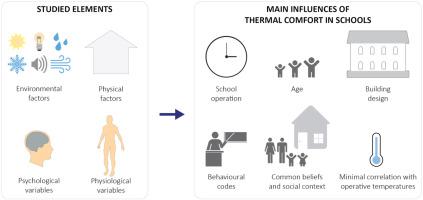Building and Environment ( IF 7.1 ) Pub Date : 2021-02-10 , DOI: 10.1016/j.buildenv.2021.107682 María Camila Coronado , Carolina Rodríguez , Juan Manuel Medina

|
This research aims to broaden the understanding of thermal comfort in educational buildings, by considering social and cultural variables during the analysis phase. For this purpose, thermal comfort assessments in two free-running schools, with 7-16-year-old children, in Bogotá, Colombia were used as case studies. The Classroom-Comfort-Data method was applied to gather information from the buildings and occupants, through environmental measurements, questionnaires, focus groups and observation logbooks. The study addressed physical and environmental factors, as well as physiological and psychological variables that affect thermal comfort in school buildings. A minimal correlation was found between the classrooms’ mean indoor operative temperatures and the thermal sensation and thermal comfort votes. Instead, factors related to behavioural codes, school operation, and building design appeared to greatly influence thermal comfort, as well as the actions children take to adapt to their environment. Other variables such as social context and common beliefs were observed to impact on how students perceive thermal environments. It was also observed that the thermal environment awareness and its effects on cognition increased with age. It is argued here that the adaptive model is an unsuitable metric to study thermal comfort in educational buildings in the local context.
中文翻译:

教育建筑中的热舒适度:“教室-舒适度-数据”方法应用于哥伦比亚波哥大的学校
这项研究旨在通过在分析阶段考虑社会和文化变量,扩大对教育建筑热舒适性的理解。为此,案例研究使用了哥伦比亚波哥大的两所免费学校的热舒适性评估,这些学校有7-16岁的孩子。在课堂舒适-数据通过环境测量,问卷调查,焦点小组和观察日志,采用这种方法从建筑物和居住者那里收集信息。该研究针对影响学校建筑物热舒适性的物理和环境因素以及生理和心理变量。在教室的平均室内操作温度与热感和热舒适度之间发现最小的相关性。取而代之的是,与行为守则,学校运营和建筑设计有关的因素似乎极大地影响了热舒适性以及儿童为适应环境所采取的行动。观察到其他变量,例如社会背景和共同信念也会影响学生对热环境的感知。还观察到热环境意识及其对认知的影响随年龄增长而增加。本文认为,自适应模型不适用于在当地环境下研究教育建筑的热舒适性。











































 京公网安备 11010802027423号
京公网安备 11010802027423号